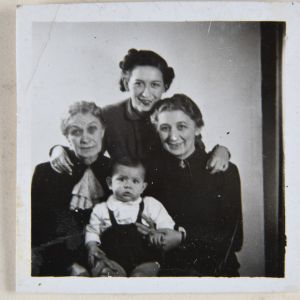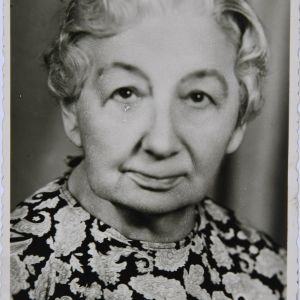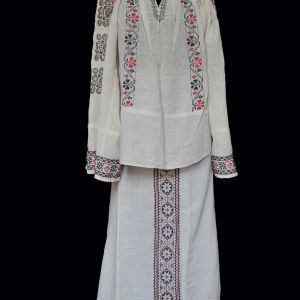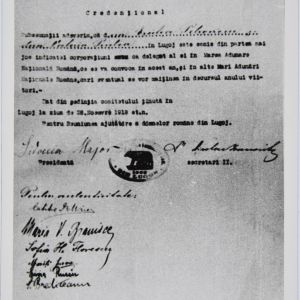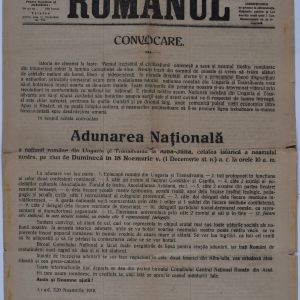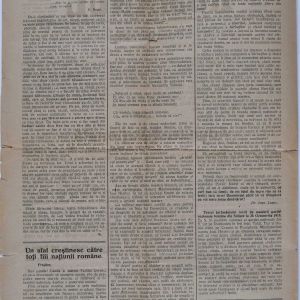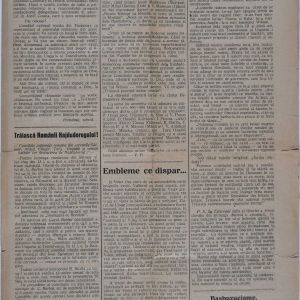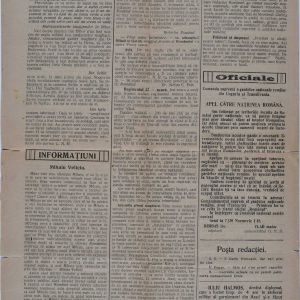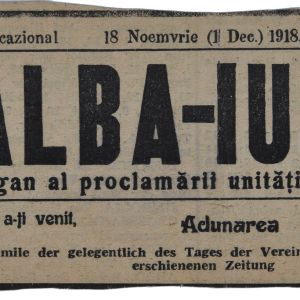E. Gojdu Street, Nr. 2
The house from the second half of the 19th century, in which Valeria dr Pintea lived after the death of her husband, doctor Valeriu Pintea, in 1940.
Listen to the audio version.
Construction built at the end of the 19th century in historicist style with classicist accents, once with the expanding of the Iosefin district to Cetatethe historical centre of Timișoara, and the organization on parcels of the buildings in Iosefin. Valeria dr. Pintea lived here after the death of her husband, doctor Valeriu Pintea, in 1940, in a two-room apartment overlooking the Mocioni Square and the Orthodox Church.
Liana Maria Gomboșiu, Valeria's granddaughter, dedicated many pages to the memories related to this apartment in the novel "Valeria dr. Pintea“, novel that appeared at the Marineasa publishing house in Timișoara in 2013 ( read the novel in pdf format on the website www.memoria.ro).
Listen to the audio version.
The building in No. 2 Gojdu street – Valeria’s second home
Liana Maria Gomboşiu, Valeria Dr. Pintea. A family novel. Marineasa Publishing House, Timişoara, 2013, p. 125, 145 - 146
In her home in No. 2 Gojdu Street, grandmother crowded disparate pieces from the furniture saved from the previous six rooms, and Buna brought a minimum of objects that composed an atmosphere much alike that of end of the 19th century Lugoj. I always found fascinating the rooms in Gojdu street and, if I could have, I would never have parted from any of the out of fashion objects that were distributed in every corner. But, out of necessity, throughout the difficult years following the war, Valeria herself had to let go some of them, and I will never forget neither Isidor Chiriţa’s bureau, a complicated piece of furniture, with two rows of superposed drawers, nor the oval table sustained by a central foot, similar to a huge torsade, ended in turn by three short feet. The Biedermeier “credenţ” was saved and on its shelves the dishes for the showy dinners that did no longer take place were kept, odd pieces from the dinner set for oysters, crabs, salad bowls and sauce pans with sophisticated handles. I will not forget the twelve thick crystal glasses with different colored irisation, a set of silver plates, with edges and handles richly ornamented. Several other objects were in the “credenţ“ situated near one of the windows, charming figurines, the gondola brought from Venice and small bronze animals that enchanted my holidays when I was a child. Every time I left for Bucharest, my grandmother offered me something from the “credenţ”, but it was impossible for me to accept those gifts, because it would have meant to take from her something I considered a real treasure, objects that I was supposed to find in their place, summer after summer. Now, of course, I regret this refusal of mine…
I loved very much the rooms in no.2 Gojdu Street, where Buna and Mama Mi had lived for several years… I still have them very clear in my mind, with every object they contained, and especially the atmosphere of old, welcoming house, where everything was kindness and harmony. How should I refrain from remembering them? How should I forget the commode with three large drawers, sheltering treasures of threads, wools and laces, velvet ribbons, needles and crochets, boxes with various buttons, buckles and buckle clasps, ornaments from dresses that no longer existed… How should I forget the cushions embroidered by Buna, the family photographs soberly framed and hung on the wall next to some genre painting and the oil painting portrait that my mother made to her brother while she was a student at the Academy of Fine Arts (actually her only painting…). And finally, there was a “dog skin”, the diploma signed by Mihály Appafi, the Transylvanian prince, framed as well, placed in the middle of the main wall and reflecting itself in the large mirror on the opposite wall. The seal that hung from the document and which was about to disintegrate after three centuries, was protected by a trivial box of Carbocif, and this detail always scandalized me. “It is the only one whose dimensions fit”, would be Mama Mi’s explanation. Among all the old furniture, the oldest and the most obsolete was the one I loved the most and this one was given to me for use during my stays in Timişoara: a small “bureau à cylindre”, with a drawer that was emptied for me, as was the headboard on which I stack my books and diaries. How did this French furniture enter my grandmother’s life? Her explanations were confusing.
Timisoara, a fairytale place
by Matei Popa, 7th grade
"Grigore Moisil" Theoretical High School Timișoara
In the pages of history, Timisoara writes its own story,
With words that remain vivid and meaningful.
On its cobbled streets walk the shadows of the past,
And the echoes of heroes can be heard in every corner and in every stone.
On the outskirts of the city, in chestnut and acacia woods,
They say there are still sighs of love and unfulfilled longings.
Love stories grow under the starry sky on the banks of the Bega,
And old legends handed down from generation to generation, like the wind caressing the leaves of old trees.
In Union Square, the heart of the city beats faster,
Among buildings and fountains shimmering in the moonlight.
Political meetings and plots take place here,
And they say that every stone holds a secret waiting to be revealed.
The narrow streets of the Citadel hide mysteries and mysteries,
And every corner has a story waiting to be discovered.
With every step, you feel like you're stepping into another era,
And you can hear the sighs of yesteryear and the laughter of children running through the old streets.
Revolutionary stories and ideas are born in bohemian cafés,
Where poets and intellectuals find refuge in words and thoughts.
At a coffee table or under gas lamps,
It sparks heated discussions and plans that will change the course of history.
On the outskirts of the city, in suburbs and suburban neighborhoods,
Stories of life and struggle for survival emerge.
Every house and courtyard has a story,
And everyone is proud of their ancestral traditions and customs.
On the border between past and present, Timisoara is building its future,
With confidence and determination, overcoming obstacles as they arise.
Every day, a new page is written in the book of his destiny,
And each inhabitant adds their personal story to the city's rich tapestry.
In the Central Park, under the shade of ancient trees,
Stories of friendship and love, joy and sadness unfold.
Every bench and alley hides memories and stories,
And every visitor adds a new chapter to the park's beautiful book.
On the border between reality and fantasy, Timisoara becomes a magical place,
Where fabulous characters meet mythical creatures.
Fairytale scenes unfold in the narrow streets and crowded squares,
And every inhabitant becomes part of a story that transcends the boundaries of reality.
At the crossroads of cultures and traditions, Timisoara becomes a melting pot of diversity,
Where customs and rituals from all corners of the world intertwine.
Every festival and holiday celebrates unity in diversity,
And everyone feels proud to be part of this multicultural city.
On the outskirts and in the heart of the city, nature shows its splendor,
In gardens and parks that stretch on forever.
Every tree and flower tells its story,
And every river and lake becomes a testament to the beauty of the city.
Through the passing years and the changes that come with them,
Timisoara remains a place full of charm and mystery.
In the hearts of the inhabitants and in their ancestral memories,
It keeps alive the flame that ignites the spirit of the city and gives it life.
At the end of the journey through Timișoara's Stories,
I turn wistfully to the city in front of me.
With a heart full of memories and a soul enriched by experiences,
I am slowly drifting away from this place of stories and magic.
With the promise that I will come back one day to discover new stories,
I leave with a light step and a smile on my lips, because I know that this city,
With all its stories, it will always be alive and vibrant,
A place where history intertwines with the present, and the future always shines in the distance.
At the crossroads, I reach up to the sky and say one last thought,
Thanking Timisoara for its beauty and wonderful stories.
With a heart full of gratitude and the desire to return,
I am leaving for new adventures, but with the promise that the memories of Timisoara will always remain alive in my soul.
–-














